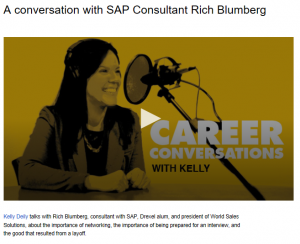– Going Beyond a Formal Learning Management System to Combine it with a Professional Collaboration and Portal Environment to Display Complimentary Assets & Resources –
 CEOs and their boards, leaders, as well as company innovators and experts, know that in order to achieve short- and long-term financial returns a solid enterprise learning strategy is a must.
CEOs and their boards, leaders, as well as company innovators and experts, know that in order to achieve short- and long-term financial returns a solid enterprise learning strategy is a must.
With the ever growing complexity of customer requirements, partner ecosystems, the global economy, combined with new and evolving products, services and solutions, a top quality learning environment is not a “nice to have” but rather a critical necessity and a competitive advantage.
To scale and grow the business.
And forge new opportunities.
The enterprise’s education leaders must consider going beyond:
(A) a “formal” learning management system (LMS) alone
“or”
(B) accepting LMS with a document repository only.
The key is to combine formal training and courses with the alignment of a less formal, complementary, and supplementary blended learning environment which we can refer to as the Digital Learning Workplace (DLW) .
A Formula to Consider:
DLW = SAP Jam + LMS (with governance, discipline, quality content, and quality design & brand attributes)
When auditing today’s learning environments do they measure up to modern standards?
The DLW works incredibly well with the SAP Jam collaboration platform by breaking down silos and optimizing business (& learning) processes. The DLW brings together the knowledge DNA of an organization to the employees (24/7, any device).
 For example…
For example…
Like a university with Colleges and Schools. Each group has their own objectives within the larger mission of the university.
Together the sum (or all the groups) is greater than the individual parts of the university.
To further this example…
Each class has formal courses as well as supplements with a range of assets and resources (i.e. Think of an accounting mid-term exam with a supplementary Harvard Business Review ”HBR” case study or TED Talks to better understand the concepts tested for in the test. Mid-term = Formal; HBR or TED Talk = less formal).
If they only had formal classes with tests, how effective would the curricula be for the students?
Equipping Employees with the DLW to Support Customers
To survive, a university as well as any organization must be ready for both today and tomorrow’s emerging (& compelling) opportunities. The DLW is a crucial element for success.
Consider employee turnover. As an organization address additions or subtractions (i.e. ~10 – 20%) in the number of employees per year… What knowledge will be shared and retained, and what will be lost or never found?
 Employees and contractors.
Employees and contractors.
Internal and external stakeholders. Early talent, older talent, and onboarding. Each depends on learning the current and new realities of the organization, marketplace, and how to best serve customers (& partners).
Each enterprise formed of teams and individuals must continuously learn about innovation, new technologies, products, solutions, services, customer relationships, core business, emerging trends, leadership & management, compliance, regulations, culture, diversity, as well as career and professional development.
Are Complimentary Learning Resources Optimizing the LMS Experience?
Going beyond formal learning may include a range of complimentary assets such as one or more of the following: custom home pages (i.e. intranet and portal) and groups, expert videos and playlists, TED Talks, HBR case studies, whitepapers, podcasts, webinars, news & updates, 3rd party courses, instructor lead workshops/courses, affinity groups, CEO & their leadership team summits, virtual and face-to-face events — all of which requires a central hub and communications to engage the audience.
For top leading organizations where brand and the quality standards matter, a DLW discipline and governance must first be achieved and then maintained.
 By way of DLW portals, intranets, home pages, and groups, each must look exceptional, have accurate, approved, and maintained content, and represent the highest-level user experience for the sake of the respective audience.
By way of DLW portals, intranets, home pages, and groups, each must look exceptional, have accurate, approved, and maintained content, and represent the highest-level user experience for the sake of the respective audience.
From an employee standpoint, when you provide a high quality DLW environment, they will be in a better position to take care of customers.
And a result…
- Lead and support growing revenues.
- Improve operational efficiencies.
- And help cut costs.
These learning environments don’t happen on their own. Only with a concerted formal “and” less formal, complimentary learning initiative with a talented core team of HR/Learning leaders, will a DLW take shape and become an impactful, invaluable resource on any device, 24/7.
Stepping Back: A Few Questions Worth Asking!
So consider your learning platforms, environments, and experiences.
Make your assessments. Ask yourself a few questions:
 Do they represent “formal” and “less formal,” complimentary learning as one system?
Do they represent “formal” and “less formal,” complimentary learning as one system?- Do they have the modern tool capabilities you require for success? Would millennials enjoy the experience?
- Do they reflect the business and learning processes required?
- Do they represent the whole …or disparate, fragmented parts?
- Do they provide current and maintained content?
- Do they showcase your organization’s brand and high quality?
- Do they provide measurabilty to extend decision support?
Every individual, team, and leader must know their part. To help the organization achieve success as champions.
They have their roadmap(s).
But are they equipped…
…with a Digital Learning Workplace at their finger-tips?
The DLW provides a modern resource with excellent capabilities to address the holistic learning requirements of the organization.
As your team considers…
What your DLW is and what it can be…
Are you ready to maximize the opportunity?
—
Useful Links
About the Author
 Richard D. Blumberg is a SAP Jam Practice leader who works with both SAP and SAP Services. He is the President of World Sales Solutions, LLC (WSS) (www.WorldSalesSolutions.com) providing 29+ years of thought leadership on a variety of “View from the Top” strategies including: Enterprise Social Business, Go-to-Market Strategies, Business Development, Talent Development, and Community Building. He and his team are recognized SAP Jam global experts for implementations, innovation, and adoption.
Richard D. Blumberg is a SAP Jam Practice leader who works with both SAP and SAP Services. He is the President of World Sales Solutions, LLC (WSS) (www.WorldSalesSolutions.com) providing 29+ years of thought leadership on a variety of “View from the Top” strategies including: Enterprise Social Business, Go-to-Market Strategies, Business Development, Talent Development, and Community Building. He and his team are recognized SAP Jam global experts for implementations, innovation, and adoption.










 Designing an intuitive user experience will increase efficiencies and generate higher value by enabling site visitors to quickly navigate the interface and find essential information, therefore optimizing businesses processes.At the same time, the interface must maintain the organization’s brand and messaging throughout the experience.
Designing an intuitive user experience will increase efficiencies and generate higher value by enabling site visitors to quickly navigate the interface and find essential information, therefore optimizing businesses processes.At the same time, the interface must maintain the organization’s brand and messaging throughout the experience.
 pressures. Advancements in technology and innovation.
pressures. Advancements in technology and innovation. to provide clear value which is highly visible with
to provide clear value which is highly visible with  the best results?”
the best results?” Extending SAP Work Zone to Google Analytics is like “turning the lights on” to help identify audience behavior, understand the engagement with content, and make better business decisions.
Extending SAP Work Zone to Google Analytics is like “turning the lights on” to help identify audience behavior, understand the engagement with content, and make better business decisions. Real Time Custom Reports – Addressing visitors’ locations, traffic sources, content
Real Time Custom Reports – Addressing visitors’ locations, traffic sources, content Improving communications (i.e. focusing on outreach & awareness)
Improving communications (i.e. focusing on outreach & awareness) CEOs and their boards, leaders, as well as company innovators and experts, know that in order to achieve short- and long-term financial returns a solid enterprise learning strategy is a must.
CEOs and their boards, leaders, as well as company innovators and experts, know that in order to achieve short- and long-term financial returns a solid enterprise learning strategy is a must.
 Employees and contractors.
Employees and contractors. By way of DLW portals, intranets, home pages, and groups, each must look exceptional, have accurate, approved, and maintained content, and represent the highest-level user experience for the sake of the respective audience.
By way of DLW portals, intranets, home pages, and groups, each must look exceptional, have accurate, approved, and maintained content, and represent the highest-level user experience for the sake of the respective audience. Do they represent “formal” and “less formal,” complimentary learning as one system?
Do they represent “formal” and “less formal,” complimentary learning as one system?
 In an Aberdeen Report, “
In an Aberdeen Report, “
 An organization’s Chief People &/or Talent Officer and their team play a big role as internal consultants within the organization to step back and assess if prehires, new hires, and cross-team hires are getting the best experience and optimizing their productivity?
An organization’s Chief People &/or Talent Officer and their team play a big role as internal consultants within the organization to step back and assess if prehires, new hires, and cross-team hires are getting the best experience and optimizing their productivity? With digital transformation new employees expect social onboarding tools to facilitate their new hire experience. For recent graduates (“Next-Gen”) who have grown up with cell phones and social media it’s important for a business to put it’s best foot forward in the hiring process using modern tools and capabilities.
With digital transformation new employees expect social onboarding tools to facilitate their new hire experience. For recent graduates (“Next-Gen”) who have grown up with cell phones and social media it’s important for a business to put it’s best foot forward in the hiring process using modern tools and capabilities.